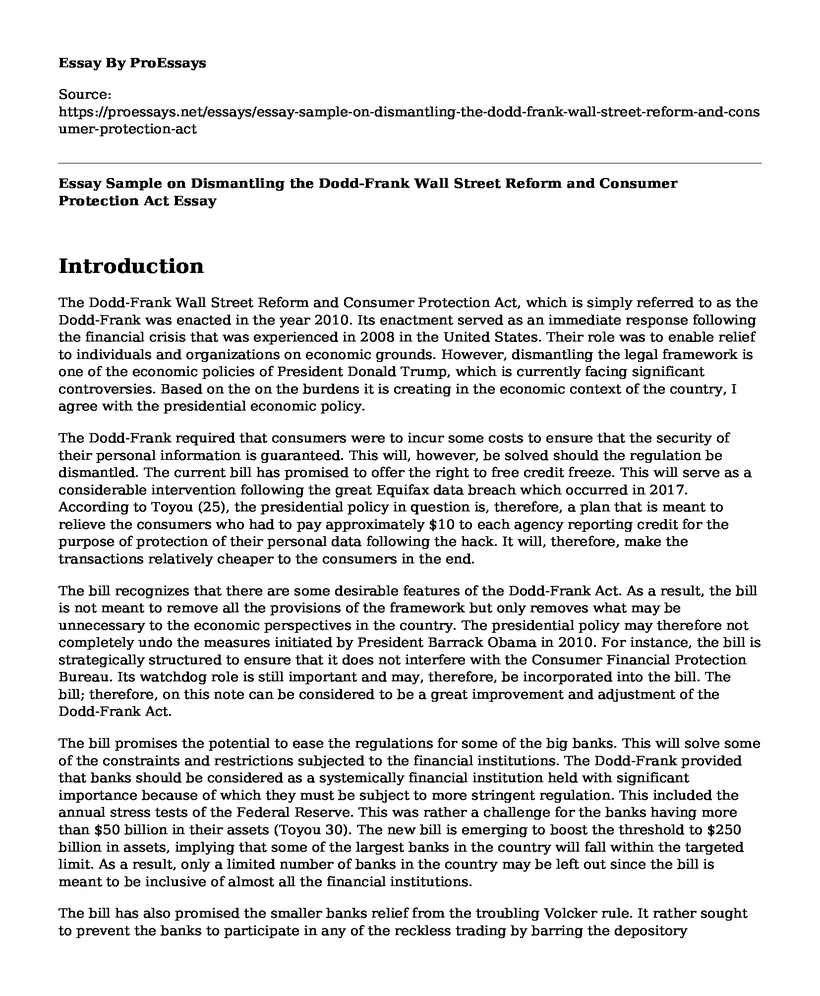Introduction
The Dodd-Frank Wall Street Reform and Consumer Protection Act, which is simply referred to as the Dodd-Frank was enacted in the year 2010. Its enactment served as an immediate response following the financial crisis that was experienced in 2008 in the United States. Their role was to enable relief to individuals and organizations on economic grounds. However, dismantling the legal framework is one of the economic policies of President Donald Trump, which is currently facing significant controversies. Based on the on the burdens it is creating in the economic context of the country, I agree with the presidential economic policy.
The Dodd-Frank required that consumers were to incur some costs to ensure that the security of their personal information is guaranteed. This will, however, be solved should the regulation be dismantled. The current bill has promised to offer the right to free credit freeze. This will serve as a considerable intervention following the great Equifax data breach which occurred in 2017. According to Toyou (25), the presidential policy in question is, therefore, a plan that is meant to relieve the consumers who had to pay approximately $10 to each agency reporting credit for the purpose of protection of their personal data following the hack. It will, therefore, make the transactions relatively cheaper to the consumers in the end.
The bill recognizes that there are some desirable features of the Dodd-Frank Act. As a result, the bill is not meant to remove all the provisions of the framework but only removes what may be unnecessary to the economic perspectives in the country. The presidential policy may therefore not completely undo the measures initiated by President Barrack Obama in 2010. For instance, the bill is strategically structured to ensure that it does not interfere with the Consumer Financial Protection Bureau. Its watchdog role is still important and may, therefore, be incorporated into the bill. The bill; therefore, on this note can be considered to be a great improvement and adjustment of the Dodd-Frank Act.
The bill promises the potential to ease the regulations for some of the big banks. This will solve some of the constraints and restrictions subjected to the financial institutions. The Dodd-Frank provided that banks should be considered as a systemically financial institution held with significant importance because of which they must be subject to more stringent regulation. This included the annual stress tests of the Federal Reserve. This was rather a challenge for the banks having more than $50 billion in their assets (Toyou 30). The new bill is emerging to boost the threshold to $250 billion in assets, implying that some of the largest banks in the country will fall within the targeted limit. As a result, only a limited number of banks in the country may be left out since the bill is meant to be inclusive of almost all the financial institutions.
The bill has also promised the smaller banks relief from the troubling Volcker rule. It rather sought to prevent the banks to participate in any of the reckless trading by barring the depository institution from investing in the hedge funds as well as the private equity funds. Besides, it was a strategic approach to control the activities of the institutions towards engaging in the proprietary trading (Toyou 35). The new bill proves effective as it exempts only the banks having less than $10 billion from the rule.
Work Cited
Toyou, Doris. "Protection of Private Equity Investors under the Dodd-Frank Act". SSRN Electronic Journal, 2018. Elsevier BV, DOI:10.2139/ssrn.3175683.
Cite this page
Essay Sample on Dismantling the Dodd-Frank Wall Street Reform and Consumer Protection Act. (2022, Nov 15). Retrieved from https://proessays.net/essays/essay-sample-on-dismantling-the-dodd-frank-wall-street-reform-and-consumer-protection-act
If you are the original author of this essay and no longer wish to have it published on the ProEssays website, please click below to request its removal:
- Which of the Following of Our Institution(s) Do You Feel Was Most Impacted by the Ancient World?
- Tax Avoidance and Evasion Paper Example
- The Two Sides of Blockchain and Cryptocurrency Essay
- Paper Example on Apple's Tax Strategies: Minimizing Corporate Tax Rate
- Paper Example on Comparing Top-Down vs Bottom-Up Budgeting: Which Is Better?
- Essay Example on Paternity Fraud: Misrepresentations and DNA Testing
- Essay on Tension Between Private and Public Policing: Budgetary Challenges and Collaboration







